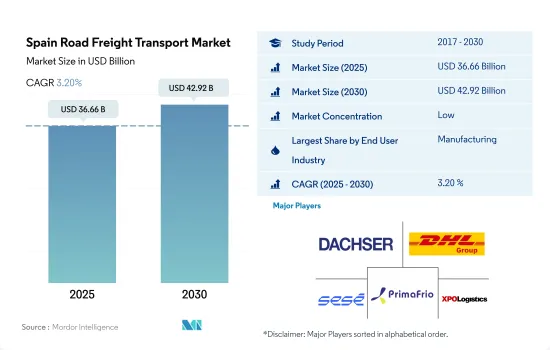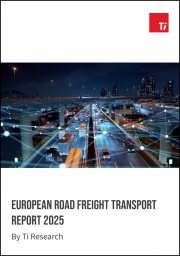
|
시장보고서
상품코드
1692552
스페인의 도로 화물운송 : 시장 점유율 분석, 산업 동향 및 통계, 성장 예측(2025-2030년)Spain Road Freight Transport - Market Share Analysis, Industry Trends & Statistics, Growth Forecasts (2025 - 2030) |
||||||
■ 보고서에 따라 최신 정보로 업데이트하여 보내드립니다. 배송일정은 문의해 주시기 바랍니다.
스페인의 도로 화물운송 시장 규모는 2025년에 366억 6,000만 달러로 추정되고, 2030년에는 429억 2,000만 달러에 이를 것으로 예측되며, 예측 기간 중(2025-2030년) CAGR은 3.20%를 나타낼 전망입니다.

전자상거래 산업은 2023-2027년 CAGR 10%로 성장해 시장 성장을 주도할 전망
- 스페인의 제조업 부문은 스페인 경제의 주요 기여자 중 하나이며 화물 운송업체에 대한 수요를 창출합니다. 스페인은 자동차, 기계, 섬유 등 수출 지향적인 산업으로 잘 알려져 있습니다. 이러한 산업은 국내 및 해외 시장으로 상품을 운송하기 위해 도로 화물 서비스에 크게 의존하고 있습니다. 2024년 7월 스페인의 제조업 생산은 비내구 소비재(8.3%), 중간재(6.6%), 내구 소비재(2.8%)의 증가에 힘입어 4.4% 성장했습니다.
- 전자상거래 산업은 2023년부터 2027년 사이에 CAGR 10%로 성장할 전망이며, 2027년에는 476억 3,000만 달러에 이를 것으로 예측되고 있습니다. 또한 스페인의 석유 및 가스 소비 증가는 석유 및 가스, 광업 및 채석 최종 사용자 부문을 지원할 것으로 예상됩니다.
스페인의 도로 화물운송 시장 동향
스페인 정부에 의한 인프라 투자 확대로 발전하는 운송 및 보관 부문
- 2024년 5월, 스페인과 모로코를 연결하는 지브롤터 해협 아래의 철도 터널 건설 계획이 부활했습니다. 조사와 비용 견적을 갱신했습니다. 당초 견적에서는 터널의 건설비는 53억 3,000만 달러에서 106억 7,000만 달러로, 유럽과 아프리카의 대출 기관으로부터의 자금 조달이 전망 스페인과 모로코를 잇는 최단 루트는 14km이지만, 거기는 바다가 약 1,000m 깊고, 건설이 어렵습니다. 취급하기 쉽습니다.현재의 계획에서는 단공 터널로, 장래적으로는 병렬로 2번째의 터널을 추가하는 옵션이 있습니다 .
- 스페인은 2024년 6월 스페인 북부의 철도 인프라 강화에 24억 7,000만 달러를 할당했지만, 이는 아스투리아스 주에 대한 30억 9,000만 달러의 대규모 투자의 일부입니다. 한편, 스페인의 교통부가 감독하는 7억 4,495만 달러의 예산에 의한 개발은 2050년의 완성을 목표로 하고 있습니다.
높은 연료 가격으로 인해 2022년 스페인 정부에서 보조금으로 리터당 0.2달러의 할인이 소매 가격에 적용
- 스페인은 연료 가격이 지속적으로 상승하는 추세를 보이고 있으며, 2024년 4월까지 휘발유 1리터당 평균 가격은 1.78달러로 3개월 연속 0.96% 상승하여 10월 중순 수준을 연상시킵니다. 반면, 경유 가격은 리터당 1.66달러로 이달 넷째 주에 0.6% 가까이 상승했습니다.
- 최근 연료 가격은 식료품비와 함께 스페인 사람들의 예산에 큰 영향을 미치는 주요 관심사였습니다. 이러한 연료 가격 하락이 예상되는 주된 이유는 공급과 수요가 모두 감소하고 있는 석유 시장 때문입니다.
스페인의 도로 화물운송 산업 개요
스페인의 도로 화물운송 시장은 세분화되어 있으며, 이 시장의 주요 5개 업체는 DACHSER, DHL Group, Grupo Sese, Primafrio 및 XPO, Inc(알파벳 순으로 정렬)입니다.
기타 혜택
- 엑셀 형식 시장 예측(ME) 시트
- 3개월간의 애널리스트 지원
목차
제1장 주요 요약과 주요 조사 결과
제2장 보고서 제안
제3장 소개
- 조사의 전제조건과 시장 정의
- 조사 범위
- 조사 방법
제4장 주요 산업 동향
- 경제 활동별 GDP 분포
- 경제활동별 GDP 성장률
- 경제성과 및 프로파일
- 전자상거래 산업의 동향
- 제조업의 동향
- 운송 및 창고업의 GDP
- 물류 실적
- 도로 길이
- 수출 동향
- 수입 동향
- 연료 가격 동향
- 트럭 운송 비용
- 유형별 트럭 보유 대수
- 주요 트럭 공급업체
- 도로화물 톤수 동향
- 도로화물 가격 동향
- 모달 점유율
- 인플레이션율
- 규제 프레임워크
- 밸류체인과 유통채널 분석
제5장 시장 세분화
- 최종 사용자 산업
- 농업, 어업, 임업
- 건설업
- 제조업
- 석유 및 가스, 광업, 채석업
- 도매 및 소매업
- 기타
- 수출처
- 국내
- 국제
- 트럭 적재량
- FTL(Full-Truck-Load)
- LTL (Less-Than-Truckload)
- 컨테이너 운송
- 컨테이너 운송
- 비컨테이너 운송
- 운송 거리
- 장거리 운송
- 단거리 운송
- 상품 구성
- 유체 상품
- 고체 상품
- 온도 제어
- 비온도 제어
- 온도 제어
제6장 경쟁 구도
- 주요 전략 동향
- 시장 점유율 분석
- 기업 상황
- 기업 프로파일
- AP Moller-Maersk
- DACHSER
- Deutsche Bahn AG(DB Schenker 포함)
- DHL Group
- DSV A/S(De Sammensluttede Vognmaend af Air and Sea)
- Grupo Sese
- International Distributions Services(GLS 포함)
- La Poste Group(Seur Geopost SL 포함)
- Marcotran
- Primafrio
- XPO, Inc.
제7장 CEO에 대한 주요 전략적 질문
제8장 부록
- 세계의 물류 시장 개요
- 개요
- Five Forces 분석 프레임워크
- 세계 밸류체인 분석
- 시장 역학(시장 성장 촉진요인, 억제요인, 기회)
- 출처 및 참고문헌
- 도표 일람
- 주요 인사이트
- 데이터 팩
- 용어집
- 환율
The Spain Road Freight Transport Market size is estimated at 36.66 billion USD in 2025, and is expected to reach 42.92 billion USD by 2030, growing at a CAGR of 3.20% during the forecast period (2025-2030).

The e-commerce industry is projected to expand at a CAGR of 10% from 2023-2027, driving the market's growth
- The manufacturing sector in Spain is one of the major contributors to the country's economy and generates demand for freight operators. Spain is known for its export-oriented industries, such as automotive, machinery, and textiles. These industries rely heavily on road freight services to transport their goods to domestic and international markets. In July 2024, Spain's manufacturing production grew by 4.4%, driven by increases in non-durable consumer goods (8.3%), intermediate goods (6.6%), and durable consumer goods (2.8%). This marks a recovery after a 4.3% decline in June.
- The e-commerce industry is projected to register a CAGR of 10% during the period 2023-2027 and reach USD 47.63 billion by 2027. The rise in e-commerce is expected to drive the growth of the wholesale and retail trade end-user segment. Moreover, rising oil and gas consumption in Spain is expected to support the oil and gas, mining, and quarrying end-user segment. In terms of consumption, oil remains the most widely used fuel in Spain, accounting for 43.8% of the total, followed by natural gas at 21.8%.
Spain Road Freight Transport Market Trends
Developing transport and storage sector fueled by growing infrastructure investments by Spanish Government
- In May 2024, plans to build a rail tunnel under the Strait of Gibraltar to connect Spain and Morocco were revived. The Spanish government hired state-owned engineering firm Ineco to update the feasibility study and cost estimates for the project. Initial estimates suggest the tunnel could cost between USD 5.33 billion and USD 10.67 billion, with funding expected from European and African lending institutions. The shortest route between Spain and Morocco is 14 km, but the sea is about 1000 m deep there, making construction difficult. Alternatives being considered are around 28 km long but at a more manageable depth of less than 300 meters. The current plan is for a single-bore tunnel, with the option to add a second parallel tunnel in the future. This tunnel would be used by both passenger and freight trains.
- In June 2024, Spain allocated USD 2.47 billion to enhance rail infrastructure in northern Spain, part of a broader USD 3.09 billion investment in Asturias. Out of this total, USD 2.35 billion is earmarked for EU projects slated for completion by 2030. Meanwhile, developments overseen by Spain's Ministry of Transport, with a budget of USD 744.95 million, are targeted for a 2050 finish. In October 2024, Spain greenlit a tripartite agreement to construct a new southern rail entrance to the Port of Barcelona, with expenses exceeding USD 805.65 million.
Owing to high fuel prices, a discount of USD 0.2 per liter was applied to the retail price as a subsidy by the Spanish government in 2022
- Spain has witnessed a consistent uptrend in fuel prices, with the average cost of a liter of petrol climbing to USD 1.78 by April 2024, marking a 0.96% increase for three consecutive months, reminiscent of mid-October levels. Diesel prices, on the other hand, stood at USD 1.66 per liter, reflecting an uptick of nearly 0.6% in the fourth week of the month. Moreover, gasoline prices have surged by 9.25% since the start of 2024, while diesel has seen a more modest increase of close to 4.5%.
- Fuel prices have been a major concern recently, along with food costs, significantly impacting Spaniards' budgets. By the end of 2024, the price of a liter of 95-octane gasoline is expected to be around USD 1.49, and diesel around USD 1.38. The main reason for this expected drop in fuel prices is the oil market, which is seeing a decline in both supply and demand. The International Energy Agency predicts that oil consumption will fall sharply, from 2.8 million barrels per day in the third quarter of 2023 to 1.1 million in 2024.
Spain Road Freight Transport Industry Overview
The Spain Road Freight Transport Market is fragmented, with the major five players in this market being DACHSER, DHL Group, Grupo Sese, Primafrio and XPO, Inc. (sorted alphabetically).
Additional Benefits:
- The market estimate (ME) sheet in Excel format
- 3 months of analyst support
TABLE OF CONTENTS
1 EXECUTIVE SUMMARY & KEY FINDINGS
2 REPORT OFFERS
3 INTRODUCTION
- 3.1 Study Assumptions & Market Definition
- 3.2 Scope of the Study
- 3.3 Research Methodology
4 KEY INDUSTRY TRENDS
- 4.1 GDP Distribution By Economic Activity
- 4.2 GDP Growth By Economic Activity
- 4.3 Economic Performance And Profile
- 4.3.1 Trends in E-Commerce Industry
- 4.3.2 Trends in Manufacturing Industry
- 4.4 Transport And Storage Sector GDP
- 4.5 Logistics Performance
- 4.6 Length Of Roads
- 4.7 Export Trends
- 4.8 Import Trends
- 4.9 Fuel Pricing Trends
- 4.10 Trucking Operational Costs
- 4.11 Trucking Fleet Size By Type
- 4.12 Major Truck Suppliers
- 4.13 Road Freight Tonnage Trends
- 4.14 Road Freight Pricing Trends
- 4.15 Modal Share
- 4.16 Inflation
- 4.17 Regulatory Framework
- 4.18 Value Chain & Distribution Channel Analysis
5 MARKET SEGMENTATION (includes market size in Value in USD, Forecasts up to 2030 and analysis of growth prospects)
- 5.1 End User Industry
- 5.1.1 Agriculture, Fishing, and Forestry
- 5.1.2 Construction
- 5.1.3 Manufacturing
- 5.1.4 Oil and Gas, Mining and Quarrying
- 5.1.5 Wholesale and Retail Trade
- 5.1.6 Others
- 5.2 Destination
- 5.2.1 Domestic
- 5.2.2 International
- 5.3 Truckload Specification
- 5.3.1 Full-Truck-Load (FTL)
- 5.3.2 Less than-Truck-Load (LTL)
- 5.4 Containerization
- 5.4.1 Containerized
- 5.4.2 Non-Containerized
- 5.5 Distance
- 5.5.1 Long Haul
- 5.5.2 Short Haul
- 5.6 Goods Configuration
- 5.6.1 Fluid Goods
- 5.6.2 Solid Goods
- 5.7 Temperature Control
- 5.7.1 Non-Temperature Controlled
- 5.7.2 Temperature Controlled
6 COMPETITIVE LANDSCAPE
- 6.1 Key Strategic Moves
- 6.2 Market Share Analysis
- 6.3 Company Landscape
- 6.4 Company Profiles
- 6.4.1 A.P. Moller - Maersk
- 6.4.2 DACHSER
- 6.4.3 Deutsche Bahn AG (including DB Schenker)
- 6.4.4 DHL Group
- 6.4.5 DSV A/S (De Sammensluttede Vognmaend af Air and Sea)
- 6.4.6 Grupo Sese
- 6.4.7 International Distributions Services (including GLS)
- 6.4.8 La Poste Group (including Seur Geopost SL)
- 6.4.9 Marcotran
- 6.4.10 Primafrio
- 6.4.11 XPO, Inc.
7 KEY STRATEGIC QUESTIONS FOR ROAD FREIGHT CEOS
8 APPENDIX
- 8.1 Global Logistics Market Overview
- 8.1.1 Overview
- 8.1.2 Porter's Five Forces Framework
- 8.1.3 Global Value Chain Analysis
- 8.1.4 Market Dynamics (Market Drivers, Restraints & Opportunities)
- 8.2 Sources & References
- 8.3 List of Tables & Figures
- 8.4 Primary Insights
- 8.5 Data Pack
- 8.6 Glossary of Terms
- 8.7 Currency Exchange Rate
샘플 요청 목록



















